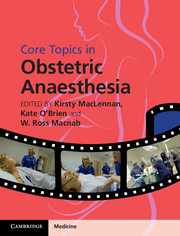Book contents
- Frontmatter
- Contents
- List of contributors
- Preface
- Section 1 Basic science, epidemiology and service organization
- Section 2 Obstetric aspects
- Section 3 Provision of anaesthesia
- 8 Incidental anaesthesia during pregnancy
- 9 Non-regional analgesia techniques for labour
- 10 Regional analgesia techniques for labour
- 11 Regional anaesthesia for operative delivery
- 12 General anaesthesia for caesarean section and transverse abdominal plane block
- 13 Anaesthesia for other obstetric indications: cervical suture, external cephalic version, controlled ARM, manual removal of placenta and perineal repair
- Section 4 Medical conditions in pregnancy
- Section 5 Postpartum complications and obstetric emergencies
- Section 6 Service organization
- Index
- Plate section
- References
12 - General anaesthesia for caesarean section and transverse abdominal plane block
from Section 3 - Provision of anaesthesia
Published online by Cambridge University Press: 05 December 2015
- Frontmatter
- Contents
- List of contributors
- Preface
- Section 1 Basic science, epidemiology and service organization
- Section 2 Obstetric aspects
- Section 3 Provision of anaesthesia
- 8 Incidental anaesthesia during pregnancy
- 9 Non-regional analgesia techniques for labour
- 10 Regional analgesia techniques for labour
- 11 Regional anaesthesia for operative delivery
- 12 General anaesthesia for caesarean section and transverse abdominal plane block
- 13 Anaesthesia for other obstetric indications: cervical suture, external cephalic version, controlled ARM, manual removal of placenta and perineal repair
- Section 4 Medical conditions in pregnancy
- Section 5 Postpartum complications and obstetric emergencies
- Section 6 Service organization
- Index
- Plate section
- References
Summary
Introduction
Over the last 40 years, the caesarean section delivery rate in developed countries has increased substantially; 9% of deliveries were by caesarean section in England in 1980 compared with 24.6% in 2008–2009. The reason for the increase is likely multifactorial including:
• Advancing maternal age at first pregnancy
• Improved safety of the procedure (both surgically and anaesthetically with the increase in regional anaesthesia)
• Changes in women's preferences
• Increasing numbers of parturients who have had a previous caesarean section.
The variation in overall caesarean section rates in hospitals in England can mainly be attributed to the variation in rates of emergency caesarean section. The use of electronic fetal monitoring and fetal scalp blood sampling, partograms, active management of labour and consultant involvement in decision-making have all been shown to affect caesarean section rates.
General anaesthesia and caesarean section
The early Confidential Enquiries report anaesthesia as the third most common cause of direct maternal death, after hypertensive disease and thromboembolism; this was mainly attributed to general anaesthesia. General anaesthesia is now more than 30 times safer than it was in the 1960s.
Neuraxial anaesthesia, with its superior safety profile and improved patient experience, has largely replaced general anaesthesia as the technique of choice for caesarean section. The Royal College of Anaesthetists, in the Compendium of Audit Recipes, 3rd edition 2012, recommends that less than 15% of Category 1–3 caesarean sections and less than 5% of elective caesareans, be performed under general anaesthesia. General anaesthesia was used for 8% of all caesarean sections in England and Wales in 2013 (Hospital Episode Statistics HES data).
General anaesthesia will always have a role in obstetric theatres and it commands special precautions, compared to general anaesthesia in the non-pregnant population.
Indications
One of the principal indications for general anaesthesia is speed. In the circumstance of a Category 1 caesarean section (immediate threat to life of woman or fetus), general anaesthesia is still the quickest and most reliable method of ensuring surgical anaesthesia.
- Type
- Chapter
- Information
- Core Topics in Obstetric Anaesthesia , pp. 83 - 91Publisher: Cambridge University PressPrint publication year: 2015



